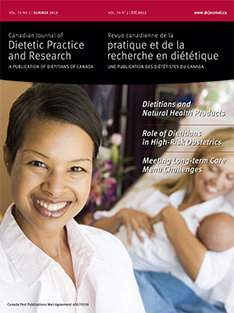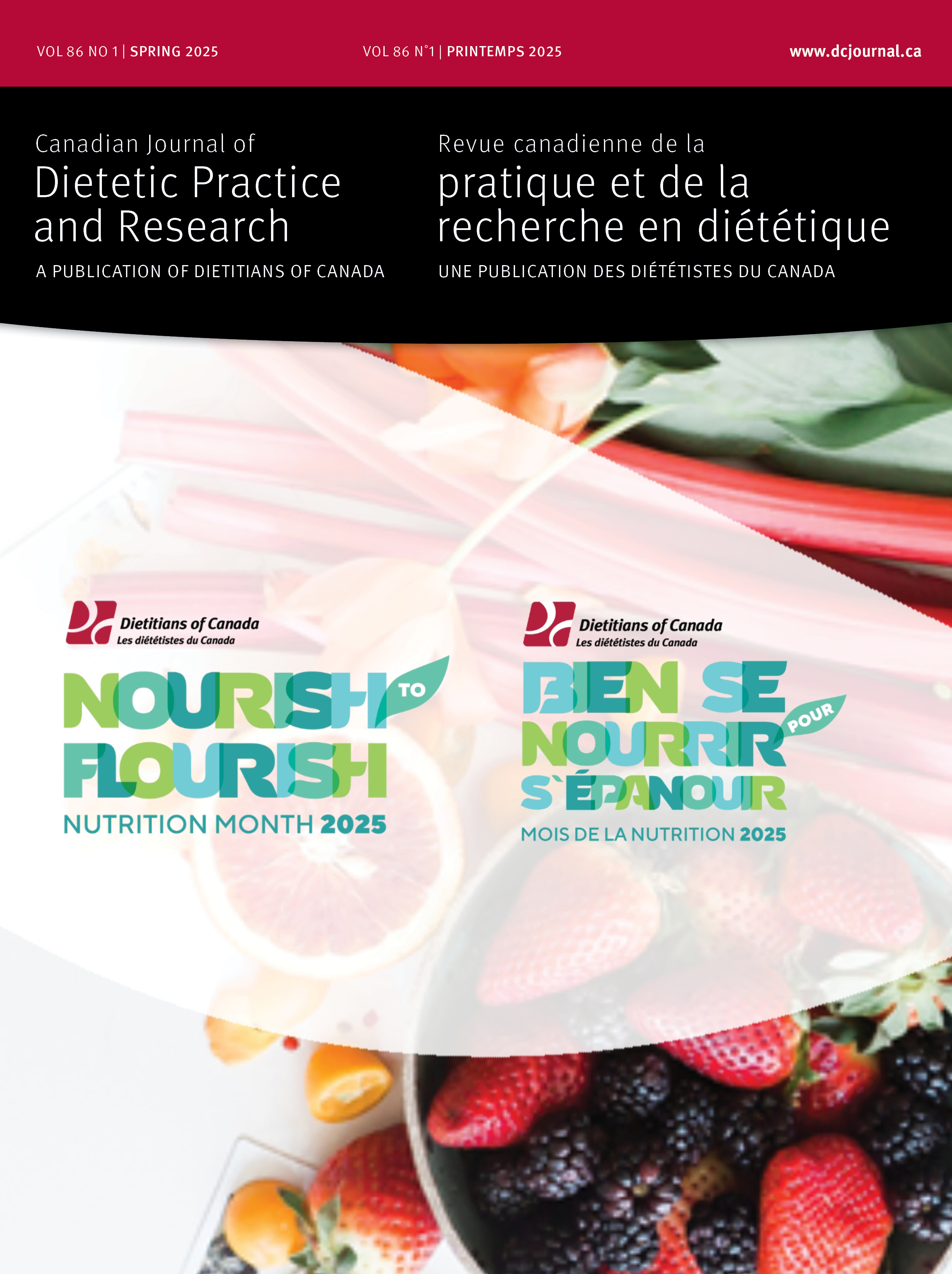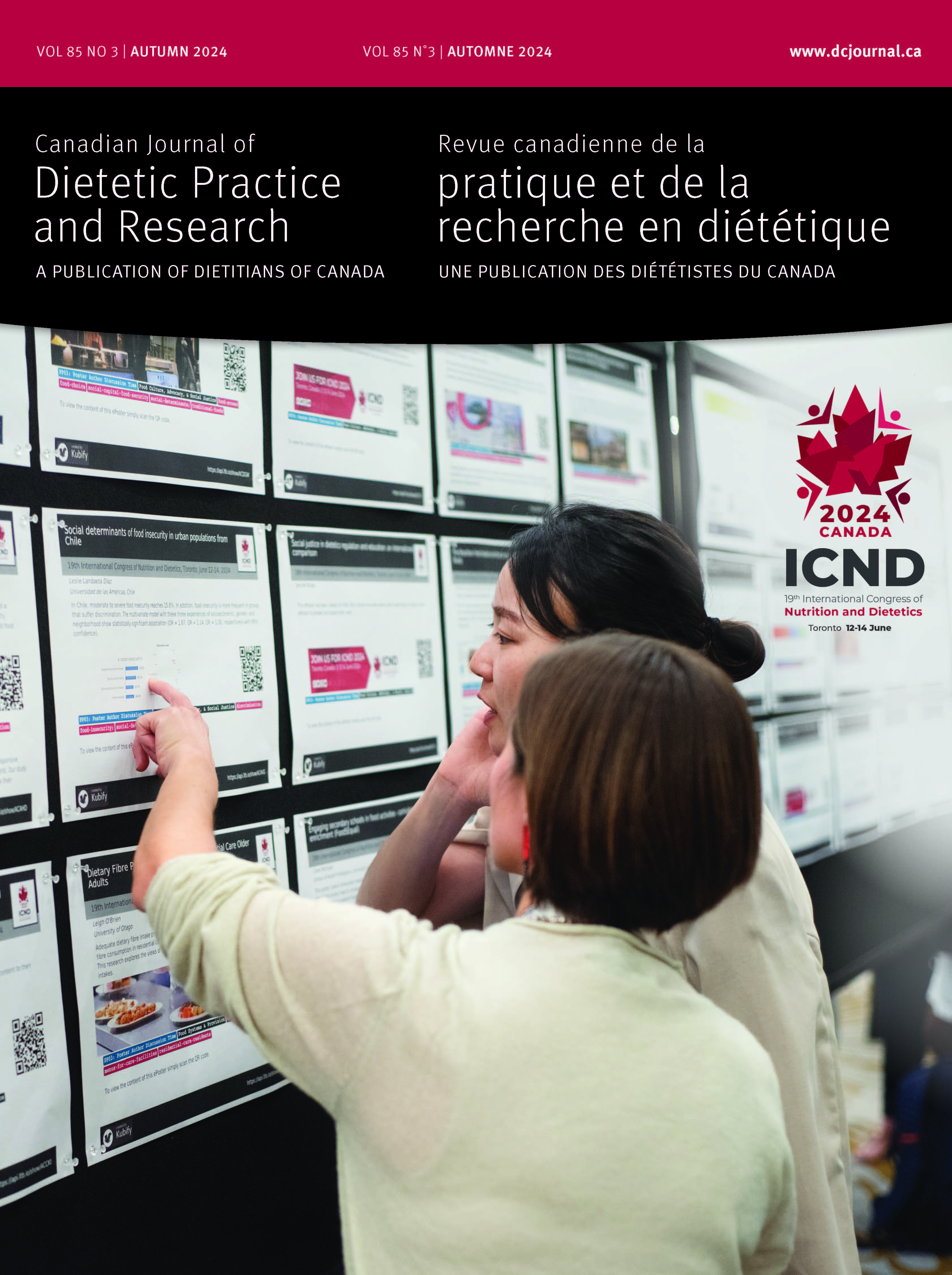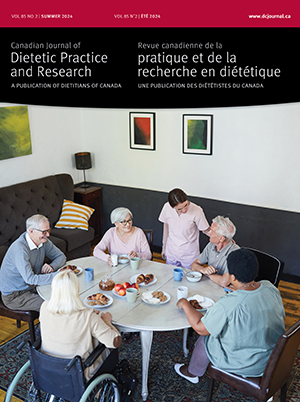Volume 74 • Number 2 • July 2013
Chair’s Message
Editor’s Message
Research
Purpose: Dietitians are experts on nutrition, and yet much uncertainty remains about their readiness and capacity to address a rapidly evolving marketplace of novel foods, nutrients, and nutrient-like substances (i.e., natural health products [NHPs]), which are available to consumers. In 2011, we conducted a qualitative examination of current thinking on the scope of practice, as well as barriers to and facilitators of dietitians’ role as experts in providing guidance on NHP use. Methods: We sought rich descriptions of existing and future dietetic competencies with NHPs. We therefore conducted six focus groups. Participants were 18 dietitians practising in rural settings and 21 practising in urban settings of Atlantic Canada. Results: Themes identified included people, products, and information; future education and training underlay these themes. The “food first” philosophy of dietetics practice was a primary convergent theme, the consensus being that NHPs can be used for select populations, lifestyles, and health conditions. The less food-related the NHP, the more divergent opinions were on specific competencies and scope of practice; focus group participants often referred to the importance of “doing no harm” and evidence-based practice. Conclusions: Dietitians’ achievement of competency in providing guidance on NHPs will require core, consistent, and crossdisciplinary information and competencies, as well as enhanced integrative practice models.
Purpose: Adequacy of intake for niacin, folate, and vitamin B12 from food was estimated in an adult population in Newfoundland and Labrador (NL). Also considered was whether study findings support current Canadian food fortification policies. Methods: Four hundred randomly selected adult NL residents were surveyed by telephone. Secondary analysis was performed on two 24-hour food recalls for each participant. Mean daily intakes of niacin, folate, and vitamin B12 were estimated from foods only and compared by sex/age subgroup. Adequacy of intakes was estimated. Contributions of folate by ready-to-eat cereal and bread products were also estimated. Results: Intakes of all three nutrients were higher in men. In comparison with recommendations, daily niacin intakes were as follows: excessive for 21.9% of all participants (and for 56.8% of men aged 28 to 54), within the recommended range for 73.6%, and less than adequate for 4.5%. In comparison with recommendations, daily folate intakes were as follows: within the recommended range for 18.1% of participants and less than adequate for 81.9%. In comparison with recommendations, daily vitamin B12 intakes were less than adequate for 36.3% of participants. Conclusions: More than 20% of those surveyed were consuming, from food alone, niacin at levels above the maximum recommended. Food fortification policies pertaining to niacin should be revisited. In addition, despite fortification, NL adults may be consuming inadequate amounts of folate from foods.
Perspectives in Practice
Advanced cancer is associated with numerous metabolic abnormalities that may lead to significant body composition changes, particularly muscle loss or sarcopenia. Sarcopenia in cancer has been associated with poor clinical outcomes, including poor physical function. Accurate tools to assess body composition are expensive and not readily available in clinical settings. Unfortunately, little is known about the efficacy of affordable and portable techniques to assess functional status in patients with cancer. We investigated the prevalence of sarcopenia and its association with different portable and low-cost functional status measurement tools (i.e., handgrip strength testing, a two-minute walking test, and a self-report questionnaire) in overweight/obese patients (body mass index ≥ 25 kg/m2) with advanced cancer. Twenty-eight patients (68% men) aged 64.5 ± 9.5 years with advanced lung or colorectal cancer were included. Sarcopenia was assessed by measuring appendicular skeletal muscle (ASM) adjusted by height (ASM index), using dual energy X-ray absorptiometry. Approximately 36% of patients had sarcopenia. Average handgrip strength was greater in men without sarcopenia than in men with it (p=0.035). In men, ASM index was positively correlated with average (r=0.535, p=0.018) and peak handgrip strength (r=0.457, p=0.049). No differences were observed among female patients. Handgrip strength was associated with sarcopenia in male patients with advanced cancer, and therefore it may be used as a portable and simple nutritional screening tool.
Beyond the management of gestational diabetes and weight control, limited literature exists on nutritional management in high-risk pregnancies. This study is a starting point for understanding the role of the registered dietitian (RD) in high-risk obstetrics (HRO) inpatient teams. Demographic information was gathered on Ontario HRO inpatient units and patient characteristics, and the RD’s role in this setting was explored. Representatives from all six HRO units in Ontario completed a questionnaire. Five of the HRO units had an RD on the team. The RDs stated that their primary role in the unit involved providing nutrition education and support, screening patients for nutritional risk, and writing vitamin and mineral orders. This was the first study in which RDs’ role in HRO inpatient units was examined. Existing literature supports the role of good nutrition in preventing and treating the conditions seen in HRO units; however, RDs’ specific role remains unclear. Future studies are needed to analyze the effect of nutrition on these HRO conditions, and to support the development of best practice guidelines.
We used our experience assisting in the development of and evaluating the Alberta Nutrition Guidelines for Children and Youth (ANGCY) as a basis for exploring roles that registered dietitians (RDs) can play within health promotion, and how others perceive the RD role. Data were generated via 12 key informant interviews and observations during a multiple case study of recreation facilities that had and had not adopted the ANGCY. We also drew on dialogue and personal observations during development of the ANGCY. Dietitians working in government, academia, community settings, private practice, and industry played an important role throughout the development and implementation of the ANGCY. Some sectors proactively sought RD expertise, while others with less ability to pay accessed RDs’ services less. Informants generally regarded RDs in a positive light. Findings indicate the profession should incrementally adjust training models to reflect emerging areas of practice, and highlight the need for RDs to proactively seek new avenues in which to apply their skills. These actions will help RDs remain the trusted source of food and nutrition information, not only in health care, but also within health promotion settings.
Report
Purpose: Long-term care (LTC) homes plan menus based on Eating Well with Canada’s Food Guide (CFG) recommendations for older adults. To determine whether recommended CFG servings and nutrients were being provided, we analyzed the menu of a large LTC facility in a metropolitan area and compared our analysis with a similar one conducted in 2000. Methods: A full week’s menu from a large Saskatoon LTC facility was analyzed and compared with CFG and recent Dietary Recommended Intake nutrient recommendations. The menu was analyzed using The Food Processor SQL. The 2011 menu was compared with the similar 2000 menu analysis to permit an evaluation of changes over a decade. Results: The 2011 menu demonstrated a significant improvement in servings of vegetables and fruit (4.6 to 7.2 servings). Servings of grain products had declined from 4.9 to 3.6 and servings of milk and alternatives had declined from 2.4 to 1.2 since 2000. Servings of meat and alternatives, total carbohydrate, and protein were not significantly different. Foods on the 2011 menu were lower in fat and higher in dietary fibre and offered more vitamins and minerals. Conclusions: Greater attention to the planning of LTC menus may explain improvements in the 2011 LTC menu. The current menu, however, needs to overcome the challenges that prevent it from meeting CFG recommendations for older adults.
Purpose: This qualitative study involved describing the experiences of dietetic students who provided meal help to older adults. Of interest were benefits and challenges, and how training could be enhanced. Methods: Individual, face-to-face, semi-structured interviews were conducted with nine undergraduate dietetic students. In the preceding year, these students had volunteered as meal helpers in a long-term care home. Interviews were digitally recorded and transcribed verbatim. Qualitative thematic analysis was used to analyze the transcripts. Results: All participating students were female and from one undergraduate program. Three main themes emerged: growing into the role, learning outside the classroom, and providing quality assistance. Conclusions: This study provides an understanding of how meal helping can be a valuable experience for emerging dietitians. It also gives insights into training and the development of the meal helper role.
Purpose: Differences in knowledge, perceptions, and consumption of whole grains were compared between students who had taken an introductory university nutrition course and those who had not. Methods: The sample consisted of two groups: 109 students who had completed a nutrition course and 61 who had not. The two samples were drawn from second-year nursing students and students in second-year psychology courses, respectively. All students completed a 25-item questionnaire. Chi-square tests were used to identify associations between completion of a nutrition course and responses. Results: Nutrition education students had more knowledge of whole grain recommendations, of whole grains available in stores, and of whole grains as a factor in disease risk reduction (p<0.05). In contrast, non-nutrition education students had more knowledge of whole grain health claims, reported a greater preference for the taste of whole grains, and had a greater than mean intake of whole grain cereals (p<0.05). Conclusions: This prelimary study indicates that completion of an introductory nutrition course has a greater influence on positive perceptions of whole grains than on students’ consumption frequency or knowledge of whole grains. Further study may provide more information on nutrition education and whole grains.
Purpose: We explored dietetic students’ beliefs about what becoming a dietitian means. Methods: A phenomenological approach to inquiry was used. Thirteen undergraduate students enrolled in a dietetics program were interviewed, and data were analyzed thematically. Results: The overarching theme was students’ expectations of what being a dietitian means and how those expectations change throughout their education. Exposure to a variety of dietitians in practice helped shape participants’ understanding of being a dietitian. Conclusions: For dietetic students to develop a strong identity as dietitians and to strengthen the profession, they must be exposed to practising professionals early and often.










